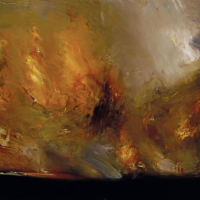49. GEOFF DYER

Winning the Archibald prize, the Nations most prestigious art award, has become something more than just a competition for the best portrait. The prize has evolved as a form of honorific, providing a ready-made tagline for every journalist and news reporter. Archibald winning artist is the new knighthood, an automatic mark of achievement and prestige, which states clearly and simply that an artist has made it, not just in the narrow world of art but also in the wider community. Some artists will strive their whole careers for that recognition, while for others, like Geoff Dyer, it is something that blows in unexpectedly, a sudden and welcome interruption to the long hard struggle of finding ones own voice and place in the world.
Well known in Tasmania when he won the award in 2004, Dyer was still to become a major name at a national level. His winning portrait of the writer Richard Flanagan (born 1961) was a tough and uncompromising work that displayed his sure command of paint as an expressive medium. For those who were then prompted to reach back into Dyers long career as a landscape painter, came the exciting realisation that here was an artist who had a great command of his craft and had learned the lessons of the past, able to reference equally the painterly surface of J.M.W. Turner (1775-1851) and the pure form of the abstract expressionists.
Being born and educated in Tasmania can be a double-edged sword it is a wonderful environment with a powerful history and a long art tradition going back to the earliest colonial times. But it can also be seen as isolated, separate and remote from the art centres of the mainland. While in travel time it is far closer to Melbourne than Adelaide, Perth or Brisbane, the simple effect of a stretch of wide water is enough to place it at a distance that is psychological as much as it is physical. While all art students are familiar with such colonial names as John Glover (1767-1849), Haughton Forrest (1826-1925), Knut Bull (1811-1889) and Robert Dowling (1827-1886), when moving into the twentieth century the list quickly peters out. While many artists have made a good living and reputation in Tasmania, there is the constant rider that one must make it on the mainland if you are to establish a real reputation. Geoff Dyer has been painting the Tasmanian landscape in its wild diversity for more than three decades. And there is much to choose from on the island state, from the rugged west coast and the remote Bass Strait islands, to the forested mountains and the scenic lakes of the central plateau. But there is also a strong political element to our understanding of the Tasmanian wilderness, the epicentre of Green political protest, the tension between primal nature and economic development, where the damming of wild rivers became the touchstone for environmental activism. Dyers paintings are at once the expression of the pure joy of paint, applied with vigour and raw power, while going to the heart of an elemental engagement with place. Just as Turner, Jackson Pollock (1912-1956) or Mark Rothko (1903-1970) would relish the physical act of painting, making the gloss and luscious oily texture of paint the actual subject of their work, the vehicle by which the significant gesture is an end in itself, so Geoff Dyer has created canvases that sing with the power of an artist in full command of both technique and imagination. And in the darkness and sudden flares of colour that erupt from his canvases there are the disturbing questions as to the fragility of the ancient land in the face of fire, storm and tempest, whether they be natural or manmade.
Gavin Fry BA[Hons] MA MPhil